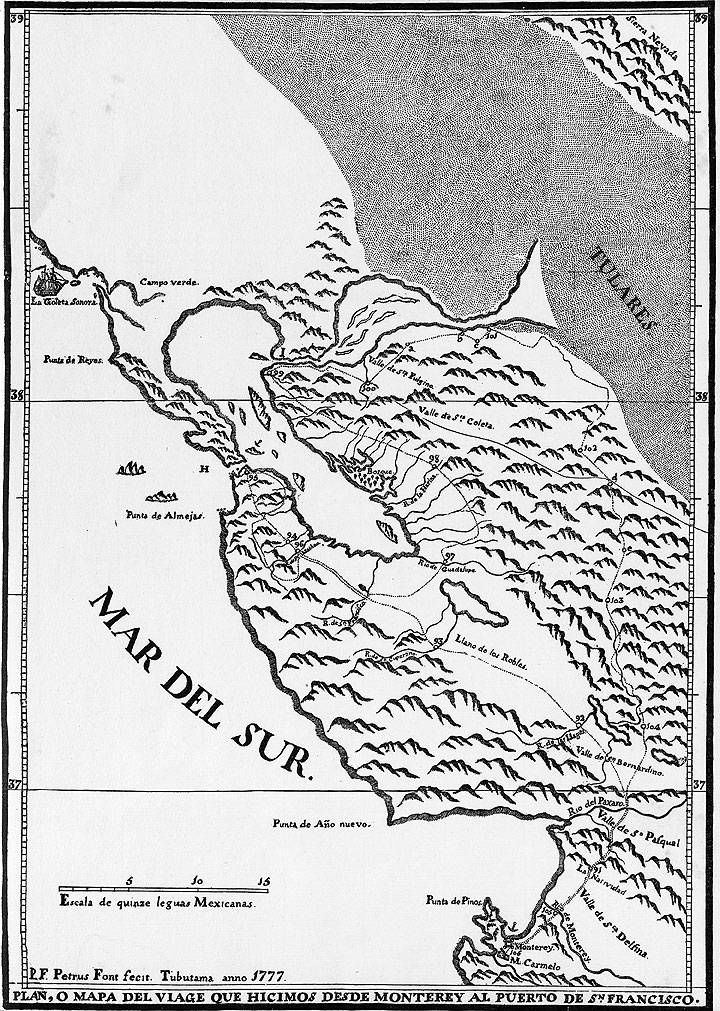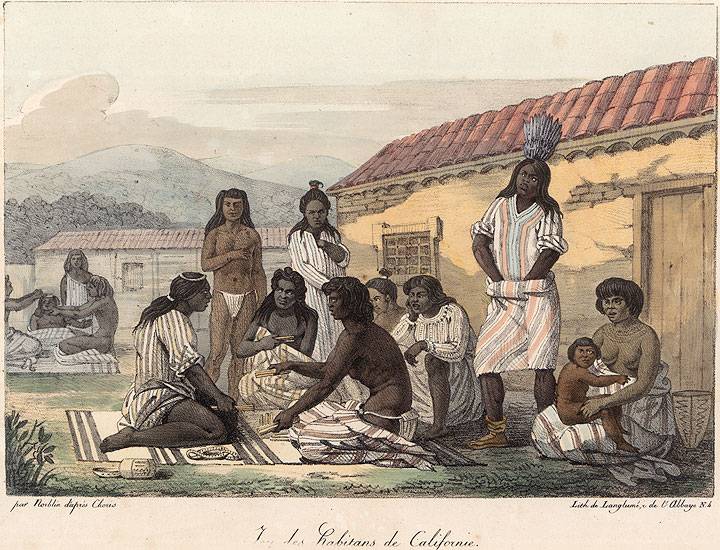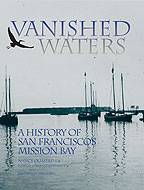The Spanish Presence at Mission Bay, 1775-1833
Historical Essay
by Nancy J. Olmsted
The first European boat to explore the waters of Mission Bay was a cayuco, or dugout, made from the trunk of a redwood taken from the bank of the Carmel River and brought into San Francisco Bay on August 2, 1775, aboard the San Carlos. As the San Carlos lay anchored off Angel Island, pilot Juan Bautista Aquirre followed his instructions to explore the southeastern part of San Francisco Bay. No diary has survived, but all later accounts agree that as the Spanish pilot entered Mission Bay he saw three Indians on shore, and they were weeping. He named the protected bay Ensenada de los Llorones—or Cove of the Weepers.15 Thus Mission Bay was discovered by the Spanish and given a name that seems prophetic for its native inhabitants.
More accustomed to horses than to boats, the Spanish soldiers and Franciscan padres explored the land around San Francisco Bay from 1769 to 1776. Considerably confused, they tried to determine if the watery expanses they saw from the hills and shores were rivers flowing into the bay or land-locked arms of the bay itself. They were charged with finding the best sites for a fort and two missions that would establish the church north of Monterey.
Using an astrolabe and a compass borrowed from the Carmel Mission, Father Pedro Font drew the best map to survive these expeditions and keyed it to his diary descriptions, complete with pen sketches of the islands in the bay. On March 29, 1776, enroute from the site chosen for the future presidio to find the most suitable spot for a mission nearby, he wrote: “Although in all my travels I saw very good sites and beautiful country, I saw none which pleased me as much as this. And I think it could be well-settled, like Europe, there would not be anything more beautiful. . . . Passing through wooded hills and over flats with good lands we encountered two lagoons and some springs of good water with plentiful grass, fennel and other useful herbs, we arrived at a beautiful arroyo which, because it was Friday of the Sorrows, we called Arroyo de los Dolores. On its banks we found much and very fragrant manzanita and other plants and wild violets. It [Mission Creek] enters the plain by a fall which it makes on emerging from the hills, and with it all can be irrigated, and at the same fall a mill can be erected, for it is very suitable to that purpose. Near the arroyo Moraga planted a little maize and chick peas to test the soil, which appeared very good and I concluded that this place was very pretty and the best for the establishment of one of the two missions.”16
Father Pedro Font’s map of San Francisco Bay. Made in 1777, it shows the route taken by various Spanish expeditions around the bay. Figure 95 is keyed to his diary description of the presidio site. The trail south, which follows the shore of the bay until it cuts inland south of Yerba Buena Island, led them to Mission Creek and the site of the Mission San Francisco de Asis. Figure 96 locates San Mateo and 97 is the site of Mission Santa Clara on Rio de Gudalupe, the second mission, founded three months after the one at San Francisco.
Image: Bancroft Library (brk00012360_24a)
In June of that same year, a number of Captain Anza’s original settlers from Sonora, now under the leadership of Lt. Jose Joaquin Moraga and Fathers Francis Palou and Pedro Benito Cambon, set out from Monterey to San Francisco. It took ten days with many stops for the struggling procession to make the trip. Some twenty soldiers, seven settlers and their families (including pregnant women and very small children), five vaqueros and muleteers riding herd on 200 head of cattle, and a mule train carrying maize and beans finally arrived at the small freshwater lagoon at the head of Mission Creek. They named the water Nuestra Senora de los Dolores, and it was here that they pitched their fifteen tents, as Father Palou praised God that they had arrived unharmed at the site for the Mission of San Francisco de Assisi. He noted in his journal that the Indians were astonished at the sight of cattle and mules, and brought mussels and wild seeds as gifts, curious to see the first white women and children to arrive at Mission Bay.
For a month the little group of settlers waited for the San Carlos, which was to bring carpenters and tools from Monterey; meanwhile Lt. Moraga explored the hills, discovering many springs of fresh water and several small lakes. When after some time the San Carlos had not arrived, he put his men to work building the presidio, leaving Fathers Palou and Cambon at the mission site with six soldiers, a settler and the cattle. When the San Carlos finally arrived, they learned that she had been blown off course all the way to San Diego, then sailed as far north as Point Reyes, missing the Golden Gate. When she did make her way into San Francisco Bay, work proceeded on building the Mission of San Francisco de Assisi. The presidio was dedicated on September 17 and the Mission on October 9, both with all the fanfare, firepower and ceremony the Spanish could muster.
In Palou’s diary he noted that the Indians were so frightened at the sound of the ceremonial cannon firing that they fled the scene. He seems to have contradicted himself, for in an August 12 entry he recorded that the Salsonas (southern Indians from the rancheria near San Mateo) had defeated the local Indians in a great fight, burning their huts so that they were forced to flee on their rafts. For several months after the battle no Indians came to hunt ducks on Mission Bay or trade with the Spanish for beads and food. The Mission San Francisco de Assisi at Dolores was completed and there were no Indians to be converted, nor did any appear until the following spring.18
Indian neophytes at the San Francisco Mission. Irv Cross, writing in 1935, describes the end of Indian slavery: “With secularization [in 1829] came the legal emancipation of the neophytes. Many of the Indians continued to suffer the lot of serfs, being treated as such by ranchers and others who had work to be done. Moreover, they refused to work either under the padres or for them, insisting that they had been freed from all connections with the missions. The greater number of them wandered off and returned to their old ways of living. Frequently they took with them the horses, cattle, and sheep of the missions, and in other ways helped themselves freely to the padres’ wealth and stores. Protest and supplication by the mission fathers were in vain.”17
Image: Bancroft Library (brk00000869_24a)
The Indians as Perceived
From their diaries and letters we know that the Spanish fathers viewed the California Indians as lost children, incapable of understanding beyond a simple level. Further, they saw them as lost souls, doomed to eternal suffering unless converted and baptized. The priests were appalled at the nearly naked Indians, smeared with mud to keep out the cold, living on acorn mush, in huts made of reeds. They saw themselves as inspired rescuers. Their plan was to clothe the Indians and teach them to weave cloth; to improve their diet and teach them to raise beans, corn, and fruit; to build permanent houses and teach them to make adobe bricks. This plan would take about ten years, the padres calculated, then the Christian Indians would settle their families on small farms, effectively colonizing California. The saving of their souls would proceed at the same time.
Fear and fascination were the means for saving souls. The adobe walls of the mission were painted with the glories of heaven emblazoned above, and below, fiery scenes of explicit tortures reserved for the damned. The recruited neophytes were quick to learn the Lord’s Prayer in Spanish and to follow the rituals of the mass. In return they were free to roam within the confines of the mission, where they attended services and found the music of bells, flutes and a small violin captivating. Missionary zeal can best be understood as the padres’ conception of an inspired rescue effort: overcome all obstacles and save the Indians from the observed hardships of this world and the certain tortures of the next.
Trouble at the San Francisco Mission
After the death of Father Serra in August 1784, followed by the departure of Father Palou for Mexico, life for the Indian converts at Mission Bay became more and more repressive. Diego de Borica, one of the most enlightened governors of California, began to look into complaints from Father J.M. Fernandez. After sleepless nights and much worry, he had written that in 1795, 203 Indians died and 200 escaped at San Francisco. The Indians were compelled to do excessive work, handcuffed, imprisoned and beaten for the most trivial offences. “When the miserable Indians, learning too late that their former gentile life, even with its precariousness, was far preferable to Christianization . . . they attempted to regain their freedom by flight. They were hunted down and punished with tenfold vigor.”19
Borica intervened at once, putting some reforms into effect, but still the Indians left the San Francisco mission at every opportunity. It is from the accounts of a handful of visitors, perhaps ten in all, that we know how the Spanish tried and failed. It should be remembered that these observers of San Francisco’s mission, much as they deplored the means and effect of religious conversion, looked upon the California Indians in their natural state as uncivilized and in need of help. Accounts written after 1815 began to list the grim statistics of Indian death by disease: measles, cholera, smallpox and “the disease given them by the Spanish soldiers” or syphilis.
Otto von Kotzebue’s Account, 1816
”. . . We entered the church. . . where we found some hundreds of half-naked Indians upon their knees, who although they neither understood Spanish nor Latin, are not allowed to miss one mass after their conversion. As the missionaries on their side, do not endeavour to learn the language of the natives, I cannot conceive in what manner they have been taught the Christian religion; the confusion in the heads and hearts of these poor people, who only know how to mimic external ceremonies must be very great. . . we were shown the dwelling-places of the Indians, consisting of long, low, clay-built houses, forming several streets. The filthy state of these barracks was beyond conception, which is probably the cause of the great mortality among the inhabitants, since of the 1000 Indians in San Francisco, 300 die annually. . . . Twice a year they are permitted to go home, which short time for them is the happiest; and I have sometimes seen them going, in large numbers, shouting on the road. The sick, who cannot undertake the journey, accompany their fortunate countrymen to the shore, where they embark, and remain sitting for days together, casting their sorrowful eyes on the distant hills. . . probably they would flee away altogether, were it not for fear of the soldiers, who take them, and bring them back like criminals. . . this fear is so great that seven or eight dragoons are enough to keep in check hundreds of Indians.”21
Capt. Frederick William Beechey’s Narrative, 1826
”If any captured Indians show a repugnance to conversion it is the practice to imprison them for a few days, and then allow them to breathe a little fresh air in a walk around the mission to observe the happy life of their converted countrymen; after which they are shut up, and thus continue to be incarcerated until they declare their readiness to renounce the religion of their forefathers. . . the Indians are so averse to confinement that they very soon become impressed with the manifestly superior and more comfortable mode of life of those who are at liberty. . . . Having become Christians they are put to trades, or if they have good voices are taught music. . . there are weavers, tanners, shoemakers, bricklayers, carpenters, blacksmiths. . . others are taught to rear cattle and horses, some to cook for the Mission; while the females card, clean and spin wool, weave and sew. In requital of these benefits the services of the Indians belong to the Mission for life, and if any neophyte should repent. . . and desert, an armed force is sent in pursuit and drags him back to punishment. . . . The animosity between wild and converted Indians is of great importance to the missions as it checks desertions. . . . The Mission in San Francisco contained a thousand converts in 1817, who were housed in small huts around the Mission; but at present [1826] only 260 remain. . . . The huts of the absentees had all fallen into decay, and presented heaps of filth and rubbish; while the remaining inmates of the mission were in miserable condition.”22
The Failure of the Missions Becomes Evident to All
In Mexico a revolution broke out in 1810 that was anti-clerical, with the result that the annual stipend of $400 was not paid to the Franciscans from 1811 to 1818. Government ships no longer stopped on any regular basis to pick up exports and drop off supplies. The Mexican agitation resulted in the secularization of all the mission lands in 1833. By then, only 204 converted Indians were left at Mission Bay.23
NOTES
14. G.H. von Langsdorff, “Voyage Down the Bay, 1806,” in The Western Gate, Joseph Henry Jackson (ed.) (New York: Farrar, Strauss and Young, 1952), 39.
15. Theodore H. Hittell, History of California (San Francisco: Pacific Press Publishing House & Occidental Publishing Company, 1885), vol. 1:392.
16. H.E. Bolton, Font’s Complete Diary, 1776-1777 (Berkeley: University of California Press, 1933), 259ff.
17. Ira Cross, History of the Labor Movement in California (Berkeley: University of California Press, 1935) 8.
18. Bancroft, History of California, vol. 1:406.
19. Ibid. 653.
20. J.S. Hittell, History of the City of San Francisco and Incidentally of the State of California (San Francisco: A. L. Bancroft & Company, 1878), 6-7.
21. Otto von Kotzebue, Voyage of Discovery in the South Sea (London: Longman Hurst, Rees, Orme and Brown, 1821), 132.
22. F.W. Beechey, Narrative of a Voyage to the Pacific (London: Henry Colburn & Richard Bentley, 1831), vol. 2:17-20.
23. von Langsdorff, “Voyage Down the Bay, 1806,” 38-39.



